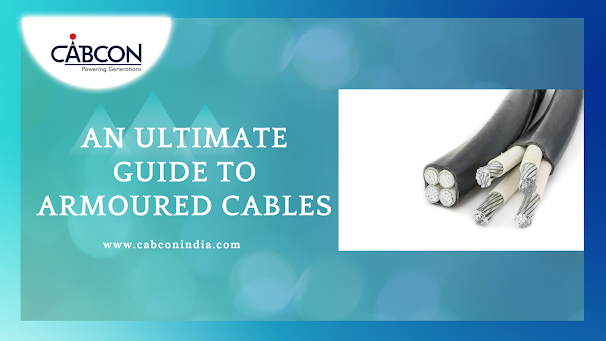The conductors of an armoured cable are protected from external
forces by a metallic coating of strips or threads. Rodents and unintentional
strikes are two external forces that make cables vulnerable. It also prevents
any internal anomalies from causing harmful energy levels to be released into
the environment. Armoured cables are encased in metal armour and insulated with
non-flame spreading thermoplastic compositions that emit less smoke and harmful
fumes. The armoured cable may be installed quickly and cost-effectively. When
we use armoured cable, we don't require a hard conduit pipe for threading,
bending, or support.
It also saves money because the armoured cable comes in
convenient lengths on continuous rolls. The armour is impenetrable to electrostatic,
magnetic, and common kinds of attack. Mechanical shielding of electrical cables
is required for outdoor installation or direct burial applications.
The different types of armoured cables are:
- Steel wire armoured cable (SWA)
- Steel tape armoured cable (STA)
- Aluminium wire armoured cable (AWA)
1. Steel wire armoured cable: Steel wire armoured cable is made
of a strong steel wire conductor and an insulating layer. In electrical power
distribution, steel armoured cable (SWA) is the most popular type of armoured
cable. It's a heavy-duty electrical power cable that can handle mains
electricity. This cable is used in 11 kV and 33 kV electrical installations
underground and in cable ducts. The shielded layer steel wire armoured cable's
main aim is to increase tensile and compressive strength. It also protects
against mechanical damage. Furthermore, shielding protection extends the
cable's service life and increases anti-interference performance.
Instrumentation applications are enhanced by blue sheathed steel wire armoured
(SWA) cables.
2. Steel tape armoured cable: Steel tape and wire armour layers
withstand low-frequency interference due to their high permeability and great
magnetic shielding action. Steel tape armouring is a popular form of fibre
optic cable protection.
3. Aluminium wire armour cable: Armoured cables made of
aluminium wire provide mechanical stress resistance, making them appropriate
for direct burial and outdoor or underground use. A magnetic field is created
when current travels through a cable. In AC systems, the magnetic field creates
an electric current (eddy currents) in the steel armour, which can lead to
overheating. Non-magnetic aluminium reinforcing prevents this because aluminium
is a non-magnetic substance.
4. Braid wire armoured cable: Several tiny copper wires are
interlaced into a tightly meshed tubular structure in a braided armoured cable.
It encircles a conductor. Magnetic fields are suppressed by braided armour
cables, decreasing electromagnetic interference between and neighbouring
cables. Copper braided cables are commonly utilised in high-speed signal
transmission situations that are also prone to mechanical damage.
For direct buried cable or pipe laying, common ground, tunnels,
and other applications, we use steel tape armoured cable (STA). The cost of STA
cables is cheaper than that of SWA cables. Steel wire armoured (SWA) cable is
appropriate for short-distance aerial laying or vertical or vertical laying
because it can sustain general longitudinal tension. The cost of SWA-protected
cables is higher since their manufacture is more difficult. In general, it is
determined by the employment of various environmental methods and the use of
various shielded SWA cables. Network cables, armoured cables, power cables, and leaflet armoured
cables are all suited for SWA cables.
Construction Of Armoured Cable:
Conductor: It's the substance that allows the current to flow.
The conductor is responsible for transporting electric current from one
location to another. Both copper cables
and aluminium cables are excellent choices for conductors.
Insulation: Depending on the cable's intended function,
insulation can be made of PVC, PVC+NYLON, Low-Density Polyethylene, or XLP.
Because of its water resistance and outstanding electrical qualities,
cross-linked polyethene (XLPE) is used in a variety of power line systems.
Bedding: The sheath is protected from mechanical harm by the
bedding. Between the inner and outer layers of the wires, bedding offers a
protective barrier.
Armour: The cable is protected mechanically by steel wire
armour. It indicates that the armoured cable can endure greater strains. It's
also appropriate for use in underground installations.
Sheath: The sheath is flexible and retains all of the cable components
in place. The cable is protected by the sheath from UV rays, water
infiltration, and varying soil compositions. It adds an extra layer of defence
against external pressures.
This is all that you need to know about armoured cables. If you
are in search of quality cables and acsr
conductors online, check out Cabcon India’s product catalogue at www.cabconindia.com!
Read More:

Comments
Post a Comment